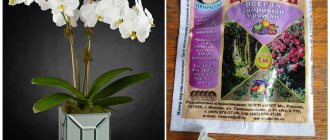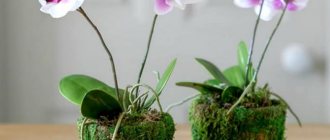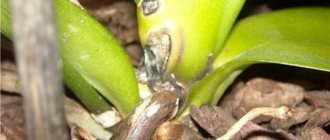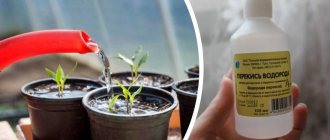Gorgeous orchids are the pride of flower growers, and it’s especially disappointing when they start to get sick. Today we will talk about all the subtleties of how to use Fundazol for orchids. This is a very effective drug, but at the same time quite strong. If you get carried away with a fungicide, you may not only not help the plant, but even completely destroy it. In addition, its use is not always effective, because the product has its own specification.
How to use foundationazol correctly according to the instructions for orchids
To create a tropical climate for orchids at home, you will have to work hard. These exotic beauties are extremely capricious and often get sick. They don’t always like the humidity, light, or temperature in the apartment. A weakened plant is especially susceptible to fungal diseases. Their occurrence can be triggered by injury to the flower during replanting, temperature conditions, or excessive watering. The fear of losing a beautiful plant forces gardeners to look for an effective and powerful remedy for fungus. Fundazol for orchids is considered one of the most popular and universal.
Reader Questions
Which manufacturers produce Fundazol?
The following manufacturers produce the product:
KFT" Hungary (Moscow representative office of "Agro-Kemi"); CJSC "August"
A remedy for fungal diseases in the garden! Bordeaux mixture
Fundazol Extra: what are its advantages?
Fundazol Extra has several advantages over drugs that have a similar effect: Efficiency:
the product has a truly unique structure and the action time is faster than similar products and the consumption rate is less.
Quality:
Fundazol Extra contains only materials of proven and high quality, which are monitored in a laboratory. Complex action and wide spectrum of action.
How long after treatment with Fundazol can the crop be harvested?
The last treatment with Fundazol should be carried out no later than a week before harvest. The fungicide Fundazol is an effective drug that will quickly help cope with fungal diseases of plants and garden crops, eliminate insects and pests
The product is effective and powerful, and therefore it is worth remembering safety precautions when working with it and, of course, strictly following the indicated dosages. Since the drug is quite difficult to find, there are analogues and substitutes for the drug.
What kind of drug is this?
Fungicides are a class of drugs designed to protect plants from fungal diseases. They can be used as preventive measures, because the fungus moves from one plant to another until it destroys all plantings. Fundazol destroys diseases from almost all parts of plants.
It has the appearance of a white powder with a specific odor. Fundazol does not evaporate and does not dissolve in water and organic matter. Active ingredient: benomyl fungicide. This component prevents fungal infections from multiplying. The fungal cells stop dividing and begin to die. In addition, the fungicide benomyl suppresses the activity of spider mites and prevents the leaf beetle from growing and becoming an adult. This is one of the few drugs that can cope with nematodes, blocking their reproduction and spread.
After the gardener treats the plants, the product penetrates through the leaves and root system. Part of the drug remains outside. When the plant is treated, carbendazim is formed, which suppresses the fungus. The infection stops spreading after using the drug.
Fundazol: description and composition of the drug
Fundazol is used for many types of plants. It is used for both prevention and treatment. It eliminates damage to the root system, branches, green mass, and seeds. This is good prevention and plant protection.
Photo of the drug Fundazol
The active active ingredient of the drug is benomyl.
It has a suppressive effect on the proliferation of fungal spores, and also dulls the activity of larvae and adult insects, including:
That is, in addition to the role of a fungicide, Fundazol is also an acaricide, insecticide, and nematicide.
Pros and cons of fungicide
Fundazol quickly penetrates the flower and affects bacterial infections. Two to three hours after application, the number of bacteria and microbes is reduced, and the spread begins to slow down. After using the product, pathogenic flora is blocked. The effect of foundationazole does not depend on the temperature during processing. The drug protects the flower equally well in heat and cold.
If more than three hours have passed after treatment, the product will not be washed off during a rainstorm. The product label indicates that the fungicide is not overly toxic. If you treat flower bulbs with foundationazole before planting, this will prevent many diseases throughout the entire growing season.
The liquid is quite flammable, so it should not be stored near open sources of fire. Foundationazol is highly flammable. The product is dangerous for aquarium fish and humans. This fungicide should not be applied to plants too often. Experienced gardeners recommend using it in the same place no more than once every three to four years.
In the United States, this fungicide is being abandoned. This drug is considered dangerous for humans and bees. The fungal infection quickly gets used to it, mutates and becomes too resistant to the effects of fungicides. At the same time, in 2014, registration of the product in our country ended, but this brand continues to be produced and used in floriculture and agriculture for treatment.
Precautions for use
When working with any toxic substance, you must be careful because it is dangerous to humans, plants and the environment. If safety measures are not followed, the orchid grows poorly, may stop blooming, and its pollen is sterilized. Chemical burns also form on the plant. To prevent this from happening, when treating orchids, you should carefully select the dosage of the drug and not use the drug too often.
When using Fundazol, the gardener must protect the skin, mucous membranes and respiratory tract from the fungicide. If the flower is processed, it should be kept at a distance from pets so that the cat or dog does not become poisoned by toxic substances.
Advantages and disadvantages of "Fundazol"
Humanity has not yet come up with a perfect fungicide. Even Fundazol has two sides to the coin.
Pros:
- the product is absolutely harmless to crops;
- the treated seed is 100% protected from fungi;
- immediate effect on pathogenic microorganisms;
- rapid penetration into the internal structures of the plant;
- the ability to be used as a therapeutic and prophylactic agent;
- The degree of protection is not reduced even in bad weather.
Minuses:
- the fungicide is very flammable;
- highly toxic and therefore dangerous for humans, fish and other fauna;
- requires strict adherence to instructions, especially when processing seeds.
Is it possible to use the pulp from the drug?
Sometimes gardeners use a remedy to treat orchids in the form of a paste. To do this, pour two teaspoons of powder into a bowl. Add a little water to the powder to mix the preparation until it becomes a homogeneous paste. The mixture should be similar in thickness to sour cream or kefir. After this, the prepared pulp is smeared on the infected areas of the flower. Additionally, gardeners treat the root system, especially if they are pruned or rotten.
This method of application has a number of opponents and defenders. Some gardeners believe that in this form the mixture is more concentrated and the orchid will recover faster. Other people familiar with the action of the drug understand that such a concentration of the substance is unsafe. In such a dosage, the gruel inhibits the growth of the plant and poisons it. It is not recommended to smear leaves, pseudobulbs and other parts of the flower with it.
This method, many gardeners believe, should be used when the roots have already been destroyed and the flower simply dies from infection. This is a measure in cases where there is nowhere to retreat and the plant will simply die without drastic action. In other cases, you should simply refrain from coating with Fundazol.
Subtleties of use
It is recommended to use the drug only for the treatment of an exotic plant, but not as a prophylaxis. The fungus quickly gets used to the active ingredient of the fungicide, so there is no need to do more than two treatments of the flower with the drug. If no effect is noticed after the first procedure, then this product is replaced with an analogue.
Processing should be carried out only in special clothing and shoes. The florist must wear a mask and gloves. The orchid is not processed in a closed room. It is best to do this outdoors. The fungicide is dissolved only in the container. No cutlery is used. After treatment, you need to wash your face thoroughly and rinse your mouth, spitting out water. One of the side effects of the wrong dosage can be growth inhibition. An orchid may simply not bloom after such treatment.
Foundationazole can be mixed when stimulating growth with insecticides and hydrogel. These agents can also be used simultaneously. The drugs can also be alternated. It is not recommended to use Fundazol with alkaline agents.
It is most convenient to work with small packages of the product so as not to calculate the dosage. It is enough for the gardener to pour half the required volume into the container. Empty the contents of the bag and add the second half of the liquid. After this, the mixture is stirred until a homogeneous solution. You can take water from the tap, but it is best to let it sit, so the powder will dissolve faster.
Some gardeners believe that the more powder they add, the better the orchids will be. This opinion is wrong. The correct concentration is important here so that the flower does not receive chemical burns. The drug is toxic. It is recommended to use the prepared solution immediately. After a few hours, the mixture simply loses its healing properties.
For which plants should the drug be used?
Fundazol can be used not only to treat orchids, but also for other plants. It is used for anthracnose, root rot, Alternaria, and powdery mildew. It is effective against mold, scab, and smut. Fundazol is used for fusarium, blackleg and other diseases.
Flowering plants, including roses, are treated with powdery mildew four times. Fruit crops can use this remedy for scab. Treatment is carried out from one to five times until the tree blooms. Gardeners recommend treating berry crops (currants, strawberries) that are affected by powdery mildew or rotting twice before flowering. For greenhouse plants, Fundazol is used as a prophylaxis even before the first symptoms of infection appear. Before planting, you can soak garlic and gladioli bulbs in an aqueous solution of the drug.
Reviews from gardeners and experts
Most flower growers and gardeners say that the drug is effective in treating many diseases. But some note its toxicity and special precautions when using it. In negative reviews, people write that the fungus quickly gets used to and adapts to this product. Experts also do not recommend using Fundazol for coniferous plants.
Experts note that gardeners often buy strong toxic drugs to treat orchids. They believe that Fundazol is a panacea for all problems and are starting to use it for prevention. This should not be done. For preventive measures, there will be safer biofungicides. If you use Fundazol too often, you can develop resistant strains of the fungus, which then cannot be cured.
Reviews
The remaining roots are lubricated. The use of foundation is one-time only. After all, it slows down growth. Plants develop slowly after its use. They may not bloom.”
Fundazol is very popular among buyers.
And more often you have to replant. I take a good look at them. I remove all damaged and diseased ones. I will treat the cuts with activated carbon. I prepare porridge from foundationazole powder. I coat all the roots with a brush. I let it dry for a couple of hours. I coat it again. Only then do I plant it in my container.”
Only in situations where there are problems with the roots. It is not suitable against downy mildew and rust. More effective drugs are quite enough now. Especially for owners of a small number of orchids in the apartment. The same Topsin-M. And another piece of advice. Don't let your orchids get into this state. To use foundationazole."
Active ingredient of the drug "Fundazol"
Under the trade name "Fundazol" a substance belonging to the chemical class of benzylamidozoles is produced. It is called benomyl and has strong fungicidal properties. It was first introduced to the agrochemical market by the notorious American corporation Du Pont back in the middle of the 20th century. Since then, controversy has not subsided around “Fundazol” and its active substance.
Benomyl is an eradicating systemic fungicide. This means that it has the following properties:
- It does not protect a healthy plant from possible infection, but kills an already developing fungus at any, even advanced, stage of the disease.
- It has the ability to spread throughout the tissues and organs of the plant and act on the fungus, regardless of its location.
Once in the plant cells, the active substance “Fundazol” undergoes a series of transformations and turns into the metabolite carbendazim. It is he who does all the main therapeutic work.
The problem with Fundazol is that microorganisms become accustomed to benomyl. This substance has been used for so long that resistant strains have emerged among pathogens that do not respond to the drug at all. Therefore, treatment with Fundazol is not always effective.
Important! On sale you can find analogues of “Fundazol” under other names – “Benorad” or “Benlat”. If the fungus does not respond to Fundazol, you should not try to treat the orchid with drugs that contain the same active ingredient.
In Russia, “Fundazol” is produced in the form of a wettable powder that forms a suspension when interacting with water. It can be found at different manufacturers of agrochemicals - Agro-Kemi, Kvadro, etc.
Advantages and disadvantages of Fundazol
The strengths of the fungicide are:
- high efficiency against many pathogens;
- direct impact on the source of infection without causing harm to cultivated plants;
- guaranteed protection of seed material from fungal infection, regardless of weather and air temperature;
- the composition of the drug, in which insecticidal, nematicidal and acaricidal components are added to enhance the positive effect;
- the ability to reduce the activity of pathogenic fungi immediately after contact with plants;
- increased stickiness, resistance to washing off by rain and water during irrigation.
The negative effect of the fungicide is expressed in the following properties:
- the possibility of toxic effects on humans, animals, bees, fish;
- high degree of flammability.
Purpose of "Fundazol" and pathogens sensitive to the drug
The spectrum of action of benomyl is quite wide, but limited. It is used to treat many plant diseases, but there are pathogens against which Fundazol is powerless:
- fusarium rot of roots and root collars;
- cercosporellosis;
- powdery mildew;
- verticillium;
- tracheomycosis.
- rust;
- Alternaria blight;
- late blight
Since Fundazol is a fungicide, it cannot be used to treat viral or bacterial lesions. Orchids suffer from bacterial infections no less often than from fungal infections, so novice orchid growers need to learn to distinguish between these types of diseases.
Properties and instructions for use of the fungicide
To correctly calculate the dosage of Benomid fungicide, you should carefully read the instructions for use. Spray the freshly prepared solution onto the plants during the growing season in the morning or evening. They do this very carefully, trying not to expose crops growing nearby to chemicals.
| Processed crops | Type of disease | Consumption rate of Benomyl | Working substance consumption rate | Waiting time |
| Winter wheat and rye | Fusarium snow mold, Cercosporella root collar rot, Fusarium root rot, Ophiopathic root rot | 0.3 - 0.6 kg/ha | 300 l per 1 ha of area | 50 days |
| Spring wheat | Powdery mildew | 0.5 - 0.6 kg/ha | ||
| Sugar beets intended for industrial processing | Powdery mildew, cercospora | 0.6 - 0.8 kg/ha | 400 l per 1 ha of area | from 20 to 40 days |
| Seed dressing | ||||
| Winter and spring wheat | Loose smut, smut, cercosorella root collar rot, fusarium root rot, fusarium snow mold | 2-3 kg per 1 ton of grain | 10 liters per 1 ton of grain | — |
| Oats | Head smut, covered smut, fusarium root rot | |||
| Winter rye | Fusarium snow mold, fusarium root rot, stem smut | |||
| Winter and spring barley | Head smut, stone smut, false head smut, fusarium root rot |
Benomid solution is used to treat all types of grains against root and fusarium rot, snow mold and cercosporella root rot. Spring wheat is sprayed with a chemical composition against loose smut. Sugar and red beets are also treated at the first signs of powdery mildew and cercospora blight.
Growing grain crops require one-time spraying. All types of beets are processed several times.
The fungicide for humans has a second class of danger, and manual work on the site can only be started after a decade. Work using mechanisms is carried out after four days. If you exceed the prescribed dosage, you can harm some varieties of earthworms.
The drug prevents the development of root infections for a long time. It stays on the foliage for a long time, providing protective functions without affecting the bacteria that are beneficial and necessary for crops. Among other things, some pine tree nurseries are sprayed with Benomyl to prevent seedlings from lodging.
Precautions when using Fundazol for the treatment of orchids
When working with Fundazol, you must remember that any chemical is potentially dangerous for the plant itself and the environment. If the rules of use are grossly violated, symptoms of intoxication can be observed in orchids:
- growth inhibition;
- cessation of flowering;
- pollen sterilization;
- chemical burns on roots and leaves.
Based on this, treatments with Fundazol should be carried out with precautions: do not use the drug haphazardly, violating the regulations and recommended dosages.
Also, when working with Fundazol, you must follow standard personal safety measures, protecting the skin, mucous membranes and respiratory tract from contact with the powder or working fluid.
If there is a cat in the house that loves to gnaw flowers, it is better to keep the orchid treated with Fundazol away from the animal - in order to avoid poisoning.
Preparation of drugs
Fungicidal preparations are rarely found ready for use. For flower growers and gardeners, they are offered in bags and small-capacity containers. Farmers have it in liters and kilograms. For a grower, grams are enough. And be sure to do it according to the attached instructions.
Calculate the required amount of prepared solution. Depending on the number of plants processed. The prepared solution should be used immediately. Without delay. Their effectiveness and efficiency are highest in the first hours. After 3-4 hours they are weaker. Not to mention those that you will want to use in a day or two.
Preparation stages:
- Prepare the water. In warm water, many drugs dissolve faster and better;
- Choose a suitable container. Use small buckets and containers. It is very convenient to use plastic mineral water bottles;
- Pour a small portion of water into the container (less than half);
- Empty (pour) the contents into the container;
- Mix well. Add the rest of the water to achieve the desired concentration.
Attention! Observe safety precautions when working with fungicides. Their high concentrations are hazardous to health. Gloves. Respirator.
Application of "Fundazol" by spraying and watering
The official regulations for the use of Fundazol provide only two ways to use the drug - spraying on the leaves and watering. However, orchids can be processed by another method - immersion of the root system.
Before processing, a working fluid is prepared from a wettable powder:
- 1 g of the drug is measured, poured into a jar and filled with 1 liter of water at room temperature;
- the mixture is thoroughly stirred to obtain a homogeneous suspension.
The concentration of the working fluid for spraying, immersion and watering is the same. After preparation, it is used immediately:
A control test is carried out 2 weeks after the first treatment. It must be performed even if the orchid shows signs of recovery after the first procedure. There is no need to treat the plant with Fundazol more than twice.
If after the first treatment the disease continues to progress noticeably, you need to think about changing the drug.
Tip #1. Benomyl disperses through tissues from bottom to top, but not vice versa. This direction of distribution of the substance is called acropetal. This means that with “Fundazol” it is better to treat the orchid below the site of infection rather than above.
"Fundazol" is used to treat orchids only in liquid form. It is strictly not recommended to pour dry powder into the substrate.
When can Fundazol be used?
Preparations with benomyl (see below) are generally best used only for the preparation of seed/planting material that is clearly contaminated with fungi, for example. from diseased plants. But there is no strong organic fungicide that does not cause resistance in the affected organisms, and Fundazol is a powerful remedy. It is possible (but still undesirable) for a private owner to use it later. cases:
- For treating obviously diseased seeds, seed tubers and bulbs. Less harmful general purpose fungicides will not cure them, and disinfection with TMTD (thiuram) or phenolic compounds is possible only under industrial conditions.
- For a one-time (no more than once every 3-4 years) replacement of another fungicide that has lost its effectiveness.
- To cure particularly valuable indoor plants with shock doses, which may still be able to grow after Fundazol, but without it they will definitely disappear.
Seed dressing
The use of Fundazol for preparing seed material is carried out as follows. way:
- Obviously affected (for example, moldy) seeds are bathed for 10-15 minutes in a thick suspension of the drug (10 g per 1-2 glasses of water) immediately before sowing;
- Rotten cloves (not whole bulbs!) of seeded garlic are soaked for 24 hours in a “solution” of 10 g of Fundazol per half liter of water. Every 2-3 hours, the seeding material is mixed, because the suspension settles;
- Seed potato nodules - same solution, soaking for 2 hours;
- Bulbs of ornamental crops of open and closed ground (amaryllis, hyacinths, gladioli, tulips, daffodils) with traces of rot are soaked for 3 hours in a suspension of 10 g of Fundazol per 1 liter of water.
Foundationazol on the site
Instructions for using Fundazol for the prevention and treatment of fungal plant diseases are given in table. below. In this case, Fundazol is the last straw to be grasped. Specifically: if you can’t get rid of harmful fungi on productive or ornamental open ground crops by other means, then once every 3-4 years you can (but still don’t need to!) try Fundazol
In this case, in no case should the dosage be exceeded, and precautions should be strictly observed during work, see below.
Norms and schemes for using Fundazol for open ground plants
Foundationazol for orchids
Healthy certified orchid seedlings are expensive, and indoor gardeners often take rejected planting material with visible signs of fungal damage. In living rooms, even such hardy representatives of orchids often become ill with fusarium; how to recognize it in orchids, see video:
Video: an example of fusarium in orchids
Orchids and other valuable indoor decorative flowers are treated for fungal diseases with heavy doses of Fundazol. An analogy with oncology is appropriate here: the medicine used is as cruel as the disease itself. Keeping in mind the dangers of Fundazol, the following preparatory measures are carried out:
- They are looking for a non-residential separate building - a barn, an outbuilding with a separate entrance.
- In the warm season, you can build a temporary shelter in the yard like a mini-greenhouse made of film.
- Prepare protective equipment (required!), see below.
- In diseased plants, flower stalks, non-viable leaves and roots must be removed.
- A plant with rotten roots is transplanted into a temporary transparent container with perforated walls, filled with a fairly large, dense, chemically neutral substrate (rounded pebbles, etc.). Pathogenic root fungi do not tolerate light and air well, this will help treatment.
The treatment procedure, depending on the degree of damage to the plant, is carried out in two ways. In case of a small or medium lesion, the plant is watered with a suspension of the drug, see video:
Video: treatment of orchids with foundationazole
If the lesion is severe and/or treatment with other means is ineffective, then a dilemma arises: after using Fundazol, he will either survive or not, but without it he will definitely perish. In this case, mix the powder with water “to the point of sour cream” (be extremely careful yourself!) and, after removing dead parts, apply the resulting ointment to the sore spots.
The use of "Fundazol" in the form of a slurry: pros and cons
In practice, orchid lovers very often use Fundazol in a way not provided for by the regulations - in the form of a paste. This paste is prepared as follows:
- take a tablespoon of powder;
- add water little by little, stirring with a wooden skewer;
- achieve a creamy or kefir-like consistency.
The product prepared in this way is taken with a brush and smeared onto the infection-damaged areas of the orchid. This technique is especially often used to treat rotten and cut roots.
This method has many supporters who believe that the pulp from Fundazol is a wonderful remedy against the spread of infection. However, this method of use raises doubts not in terms of effectiveness, but in terms of safety.
Elevated concentrations of benomyl have a depressing effect on plants. In no case should you smear the green organs of orchids with the paste - leaves, pseudobulbs, peduncles. The “coating” method can be justified only in one case – when the plant has completely lost its roots and dies from infection.
Security measures
The stability of the drug is characterized as long-term
Therefore, after treatment, take precautions for at least 7-10 days (after inspection, wash your hands and use protective equipment)
Hazard class – 2. This indicates an increased toxic effect on all living organisms. It is dangerous for allergy sufferers to carry out any activities with Fundazol: it causes an allergic reaction in the form of skin rashes and swelling of the mucous membranes. It has a strong effect on the reproductive system and is slightly soluble in liquid and soil. Complete disintegration occurs within six months.
It is strictly forbidden to apply the product to soil that is close to water bodies. The minimum permitted distance is 2.5 kilometers. All preparatory work takes place in the fresh air, wearing protective clothing, away from residential buildings. The product is especially dangerous when used by a woman during pregnancy.
After working with the drug you should:
- dispose of items that were used for processing;
- wash your hands under running water;
- take a shower;
- drink up to 400 ml of milk. This liquid acts as a neutralizer.
If the working solution gets on your skin or mucous membranes, go to the hospital for help.
First aid is provided by washing the damaged areas in manganese or salt water. Be sure to provoke a gag reflex and take intoxication neutralizers.
Reviews from flower growers about the use of "Fundazol" for the treatment of orchids
“Fundazol” is indeed on the list of the most popular fungicides among orchid lovers. This even led to the emergence of a slang verb - “foundation”. For the most part, the use of this drug for treatment is effective, although there are opposing opinions:
“I recently noticed some nasty mold on the roots of my phalaenopsis. I watered it with Fitosporin, but after a month not only the roots in the pots began to mold, but even the aerial ones. Out of fear, I took “Fundazol” and foundationalized my entire orchids - and watered and sprayed them. All the flowers immediately fell off, but the mold disappeared and has not yet returned” (Evgeniya, St. Petersburg).
“I threw this drug out of my “flower medicine cabinet” a long time ago and forever. Three years ago I got a new Vanda, which was brought to me from Thailand as a gift. Together with Vanda, a particularly malicious spot came into the house, which manifested itself after quarantine and infected almost all the orchids. Out of habit, I tried to treat with Fundazol - zero reaction. As a result, I lost time and 3 excellent copies. The rest were saved by the usual ambulance. I think Asians abuse benomyl on their farms, that’s why this happened” (Oksana, Yekaterinburg).
Dosage and application features
The instructions for use indicate that treatment can be carried out in various ways: spraying, spilling soil at the roots, treating seeds. In total, two treatments can be carried out in a season, but after that, over the next 2 - 3 seasons, the use of benzimidazoles will be ineffective, since Fundazol quickly causes fungal resistance to the active substance.
The number of uses of the product may also depend on the existing pathology:
- spotting (of any kind) – from 2 to 4 procedures;
- mold on planting material – 1 time;
- gray rot, bulbous rot, root rot - twice application;
- powdery mildew – triple treatment;
- Fusarium - double use.
For vegetable crops
Fundazol can be used equally effectively for garlic and onions, as well as for tomatoes and cucumbers. In this case, the average dosage is 10 g of the substance per 10 liters of liquid.
cucumbers
Instructions for use of Fundazol for cucumbers determine the dosage of the drug in the treatment and prevention of the development of powdery mildew. For therapeutic purposes, at the first symptoms of the disease, the fungicide is diluted at the rate of 10 g per 10 liters of water, for preventive measures - 5 g per 10 liters.
Tomatoes
Tomatoes are treated in the same dosage at the first manifestation of symptoms. The product can also be used for seed treatment. The instructions determine the dosage for preparing the solution in the proportions of 1 g of substance per 1 liter of liquid.
Expert opinion on the preventive use of Fundazol
There is another subtle point regarding the use of Fundazol, which some experts mention:
“In my practice, I have come across the fact that flower growers use very strong chemicals to prevent infections. For some reason, “Fundazol” is especially popular, which is considered almost a panacea for all orchid ills. This is a serious mistake. For preventive purposes, you need to use simple and harmless biofungicides or, in extreme cases, non-systemic drugs. And “Fundazol” is an eradicating agent. If you just pour it on your orchids, in the future you can breed resistant strains of fungi in your flower garden, which will be very difficult to get rid of.”
A. Davydovskaya, owner of the greenhouse
Features of the drug
"Fundazol" is a non-volatile substance that is white in color. A characteristic feature of the product is its geographical versatility. In other words, the drug can be used both in the northern regions of Russia and in the southern ones.
The main advantages of the fungicide are:
- Resistant to temperature changes. The product will work equally effectively in both summer and winter. This makes Fundazol a relatively universal drug.
- Gentle treatment of soil structures. Despite the fact that the fungicide belongs to the category of phytotoxic substances, it does not violate the quality characteristics of the soil. That is why the product is actively used in soil cultivation. This type of processing is considered the most effective way to supply the plant crop with the necessary substances.
- Extensive impact. The active components have an effect on all parts of the plant.
"Fundazol" has acaricidal, bactericidal, nematocidal and fungicidal properties
Release forms
“Fundazol” is produced in the form of a white or milky powder. The drug is packaged in small volumes - 10 or 20 g. This dosage is convenient to use, since an open package of powder does not last long.
Compatibility with other tools
The drug, as a rule, is well compatible with many fertilizers, growth stimulants
However, this does not at all exclude the need for careful combination of substances. The main rules for using a fungicide in parallel with other agents are:
- Substances belonging to the group of benzomidazoles are incompatible with the fungicide.
- Products that behave neutrally when in contact with water can be combined with Fundazol.
- It is not recommended to use Fundazol simultaneously with alkaline compounds. The alkali completely neutralizes the components of the fungicide and it loses its properties.
Current questions about the drug "Fundazol"
Question No. 1. Is it possible to combine Fundazol with Fitosporin?
Can. “Fundazol” is an antifungal agent, and “Fitosporin” contains bacteria. Benomyl has no effect on them, like all other bacteria. Therefore, treatments with “Fundazol” and “Fitosporin” can be carried out simultaneously. Another tactic is also possible: do the first treatment with “Fundazol”, and the second, after 2 weeks, with “Fitosporin”. This will help reduce the pesticide pressure on orchids.
Question No. 2. Is it true that pregnant women cannot work with Fundazol?
Rumors about the teratogenic effect of benomyl have been circulating for a long time - both in the Western press and in Russia. No one has yet been able to prove this. Officially in Russia, benomyl preparations are classified as low-hazard to humans. But if there are any fears and doubts, it is better to put “Fundazol” away during pregnancy and treat orchids with biofungicides.
General information about foundationol
A representative of the benzimidazoles class contains the main substance - benomyl, in an amount of 500 grams per kilogram of weight.
Externally, foundationazole looks like a white powder with a corrosive odor, but not clearly expressed.
The drug does not dissolve in liquids or organic matter. It remains on the foliage as a thin white film. In this case, the main substance penetrates into the plant system through foliage and roots.
Characteristics of the drug
Fundazole has the second hazard group, being a strong toxic substance.
The effect of using the drug is due to the cessation of the cultivation of the fungus during its processing. Influencing the cell nucleus of the pest, it destroys and blocks it. It is best to water the roots with the solution and treat the seeds.
Watering the stems and leaf axils of cultivated plants is allowed. After watering after three days, foundationazol will remove external signs of the disease, and will maintain the effect over the next week, thereby preventing new pathogens from appearing.
The drug easily tolerates any temperature, maintaining its protective properties. It is used from early spring until late autumn.
Fundazol can be combined with those drugs that have a neutral reaction in water solution. It is incompatible and dangerous only with lime and alkali. The benomyl contained in it sometimes exhibits insecticidal properties. Therefore, it inhibits leaf beetle larvae and aphids, impregnating whitefly eggs with toxins. There are suggestions that benomyl has a nematicidal effect.
Indications for use
There are a number of plant diseases and their prevention where foundationazole is used:
- Anthracnose, ascochyta blight and alternaria blight.
- Rot of various types.
- Seed mold.
- Black leg, fusarium.
- Powdery mildew.
- Stem, firm smut, rhizoctanio.
- Fading.
Fundazol is used for garden crops, ornamental and agricultural plants. They can also be used to treat flowers, shrubs and fruit-bearing trees.
It is important to take into account that foundationazole added to the ground in large quantities inhibits plants. It is worth knowing this before using the drug
Action
The substances that make up the foundation penetrate into the plant system, which resembles vessels, and move along it in the acropetal direction.
In simple terms, it spreads in the vertical direction. Watering the root system is considered to be in first place in terms of efficiency. No less effective is spraying. But, the result will be visible only in the places where the drug hits.
Plants located near the treated areas are not exposed to the foundation.
Not everyone considers fungicide an effective means of pest control. Especially flower growers who grow indoor flowers have different opinions about it. Foundationazole is loved by those who work with orchids and bulbous flowers.
But due to increased toxicity, it is not advisable to use the drug at home.
How to use Fundazol for orchids: subtleties of fungicide treatment
Gorgeous orchids are the pride of flower growers, and it’s especially disappointing when they start to get sick. Today we will talk about all the subtleties of how to use Fundazol for orchids. This is a very effective drug, but at the same time quite strong. If you get carried away with a fungicide, you may not only not help the plant, but even completely destroy it. In addition, its use is not always effective, because the product has its own specification.
Release forms. Hazard Class
White or cream powder
- Can be purchased in various packages. Small packaging is convenient and practical for flower growers. 10, 20 grams per package. After all, the prepared solution should not be stored for a long time;
- Fundazol belongs to the second class of danger for mammals. This is quite a high level. Reminds me of Carbendazim and Fundazim. For birds and bees, its danger is classified as class 3-4. But its effectiveness outweighed its danger. And it was used;
- The duration of the protective effect is from 7 to 20 days;
Fundazol is a white powder that must be dissolved before use.
When is the use of the drug justified?
The active ingredient of Fundazol is benomyl. It quickly enters the plant itself and spreads through the leaves. The drug copes well with fungal diseases, but is powerless against viral and bacterial infections.
A systemic fungicide will help cure orchids from the following diseases:
- fusarium rot;
- powdery mildew;
- tracheomycosis;
- verticillium;
- cercosporellosis.
The drug is powerless against downy mildew, late blight and alternaria.
Fundazol should only be used to treat orchids. It is not used as a prophylactic agent. Moreover, the fungus quickly gets used to benomyl, so the maximum number of treatments is no more than two. If there is no effect after the first procedure, then you should change the drug to one that contains a different active ingredient.
Application
Fundazol can be used to treat or prevent infection of garden crops by pathogenic microorganisms. In addition to the fact that the drug is an effective fungicide, it also has the following beneficial properties:
- reduces and suppresses the activity of spider mites - both larvae and adults;
- inhibits the development of leaf beetle larvae;
- destroys microscopic worms that damage the root system and above-ground parts of plants.
In order for the product to bring maximum benefit to the garden, you should strictly follow the instructions for its use.
Preparation of solution and dosage
The method of preparing the working solution of Fundazol depends on what diseases and on what crops it is planned to be used:
- when plants are affected by gray rot, powdery mildew, scab or spotting, the recommended dosage of the drug is 10 g per 10 liters of water;
- when cabbage is infected with clubroot, the correct dosage is 10-15 g of fungicide per 10 liters of water.
The prepared solution cannot be stored, so it is necessary to dilute the drug in such a volume that it can be used in one treatment. Before diluting Fundazol, you should definitely check the expiration date of the drug.
Expired fungicide should not be used under any circumstances.
Toxicity and precautions
The drug "Fundazol" is assigned hazard class 2. This means that this fungicide has carcinogenic properties and can cause some harm to the health of people and animals within its field of action, including:
- may provoke an allergic reaction;
- irritates the mucous membranes of the nasopharynx;
- negatively affects reproductive functions in animals;
- prolonged contact of Fundazol with the skin often causes the development of complex dermatological diseases and burns.
How to use Fundazol for orchids: methods of treating plants
The fungicide is available in the form of a soluble powder. Based on it, a working solution is prepared (1 g of the drug per 1 liter of water) and orchids are treated with it in one of the following ways:
- Spray leaves, stems, bulbs.
- Spill the bush after placing it in a bowl. In this case, the substrate must be moist, and no more than 1 tbsp is “wasted” on one orchid. solution.
- Immerse the roots and leave for a quarter of an hour.
If the disease is advanced and the orchid’s roots have already rotted, an emergency method can be used. Make a paste from the powder by adding a little water. Apply this mixture to the remaining rosette or remaining roots, cleared of rot. It is strictly forbidden to treat healthy leaves, bulbs and peduncles.
Do not exceed the recommended dosage and frequency of flower treatments. The fungicide, although good, is very strong. It will kill the fungus, but the orchid itself may stop growing and blooming. Repeated treatment is carried out no earlier than after 2 weeks. If necessary, Fundazol can be combined with Fitosporin.
Methods of using the drug:
Seed dressing
Planting material is processed immediately before planting:
- Before planting, seeds are bathed in the prepared suspension (10 grams per 300-400 grams of water) for about 15 minutes. And allowed to dry;
- In 2-3 hours, using a good sprayer, the bulbs laid in one row are sprayed with a solution of 10 grams per 2 liters;
- You can also treat it using the method of short-term immersion in the prepared solution. Let them dry. And plant it.
Watering the substrate
Many orchid diseases can be caused by soil conditions . Not quite the correct selection and ratio of substrate components for a particular orchid does not allow the plant to develop well. The soil must be replaced every 2-3 years.
Treatment of the substrate allows you to neutralize overwintering disease spores . After watering the substrate, it must be dried. And only after that use it when transplanting.
Fundazol is not used in powder form for sprinkling soil.
Is it possible to spray leaves during the growing season?
This drug is rarely used for spraying vegetating orchids . Especially in a private house or apartment. To do this, use less toxic drugs.
Leaves are rarely sprayed with foundationazole.
Compatibility with other drugs and fertilizers
Many growth stimulants and insecticides can be mixed for simultaneous use with foundationazole:
- Alkaline preparations cannot be used to prepare tank mixtures with foundationazole. Drugs from the benzimidazole or thiophanate group;
- Including alternating their use.
Precautions when working with the drug
to prepare a working solution from foundationazole powder . It is more convenient to work with small packages. To avoid calculating the powder to water ratio:
- We poured a little less than half of the required water into the container;
- Empty the contents of the package;
- Stir until dissolved;
- Add water to the required volume;
- Let it sit for a bit and use.
Water requirements for preparing the solution:
- The most ordinary water can ;
- Better warm and settled;
- For faster dissolution.
Overdose:
- It is better to make a concentration greater than what is written in the instructions. Many gardeners and gardeners think so. Considering my experience;
- This should not be done with orchids. Everything is better in moderation! An overdose for orchids can only do harm . Consider the properties of this fungicide. It's already quite toxic.
Shelf life of the prepared solution:
- the prepared fungicide solution immediately ;
- After 3-4 hours, the mixture you prepared begins to lose its properties .











